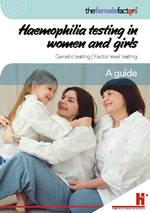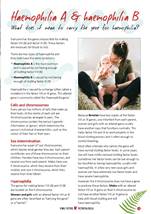Can females have haemophilia?
Girls or women who have the gene alteration causing haemophilia can have normal or reduced factor VIII (8) or factor IX (9) levels.
In genetics any female who has this gene alteration is called a ‘haemophilia carrrier’.
Around 70% of females with the gene alteration have normal factor levels and do not have bleeding symptoms.
However, approximately 20-30% of girls and women who are carriers have reduced clotting factor levels. They often have bleeding symptoms and can have haemophilia.
In the past women and girls with bleeding symptoms were generally described as ‘symptomatic carriers’.
Now if their factor levels fall in the range for haemophilia (less than 40% of normal clotting factor), they are diagnosed as having the medical condition haemophilia.
- Usually they will have mild haemophilia (5 – 40% of normal clotting factor).
- In very rare cases, some girls or women have particularly low factor levels causing them to have moderate or severe haemophilia.
- Some females with factor levels at the lower end of normal (40-50%) may also experience abnormal bleeding. If further investigation shows that this bleeding is related to a factor VIII or IX deficiency, they will be treated as having haemophilia, but they will be described as a ‘symptomatic haemophilia carrier’.
Factor level testing
All girls and women who are carriers should have testing for their clotting factor levels at least once, preferably as soon as a girl shows bleeding symptoms or before she starts menstruating.
If their factor levels are low, they will need a treatment plan to prevent bleeding problems and manage any situation that may occur, including medical and dental procedures and surgery.
Females with lower factor levels should have them checked periodically, as their factor levels may change with age, pregnancy and hormonal medications.
Unlike males with haemophilia, where the factor level is nearly always the same within the same family, the factor level in females who are carriers is unpredictable and varies between family members.
It is important to remember that normal factor VIII or factor IX levels will not tell you whether you have the gene alteration causing haemophilia.
- Many females who carry the gene alteration have normal factor levels.
- Finding out your clotting factor level helps you and your Haemophilia Treatment Centre decide if you need to develop a treatment plan specifically for you.
- If your levels are normal a separate genetic test is needed to find out if you have the gene alteration.
Click here for more information on genetic testing
See the HAEMOPHILIA TESTING IN WOMEN AND GIRLS section for detailed information
Or read the booklets:
Shorter/simpler version
A guide to haemophilia testing in women and girls (genetic testing and factor level testing)
More comprehensive version
Haemophilia testing in women and girls: your questions answered (genetic testing and factor level testing)
Download the fact sheets:
Haemophilia in females (PDF, 1.1 MB)

